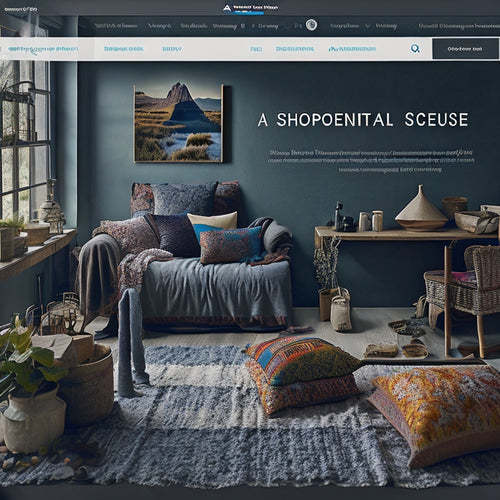
Create Digital Products That Grow Your Business
Share
You can create digital products that drive sustainable revenue and scalability by applying a structured approach that targets specific audience needs, crafts engaging content, and leverages strategic marketing and sales strategies. Identify your ideal customer through market research, gathering data on demographics, preferences, and pain points. Develop valuable resources that solve problems effectively, and structure your online course logically for easy absorption. By implementing agile development practices, establishing time-bound deadlines, and optimizing sales channels, you'll be on your way to growing your business with digital products. Now, it's time to turn your vision into a reality.
Key Takeaways
• Identify your ideal customer through market research to create targeted digital products that solve their specific pain points.
• Develop high-quality, engaging digital products with clear learning objectives and measurable outcomes to drive business growth.
• Implement agile development practices and conduct market research to define clear objectives and ensure successful digital product creation.
• Optimize sales channels by selecting high-conversion platforms and allocating resources effectively to maximize revenue potential.
• Foster a community support system to drive long-term engagement, encourage collaboration, and gather user feedback for continuous improvement.
Identifying Your Target Audience
To successfully create a digital product that resonates with users, you need to pinpoint your ideal customer by gathering data on their demographics, preferences, and pain points. This is where market research comes in – a vital step in understanding your target audience.
Through surveys, focus groups, and online analytics, you can collect valuable insights that will help you create a product that meets their needs.
Next, you need to segment your audience into distinct groups based on their characteristics, behaviors, and goals. This process, known as audience segmentation, allows you to tailor your product to specific groups, increasing its relevance and appeal.
By identifying your ideal customer, you can create a product that speaks directly to them, addressing their pain points and solving their problems. With a clear understanding of your target audience, you'll be able to develop a product that resonates with them, ultimately driving engagement, loyalty, and revenue.
Crafting Compelling Course Content
Now that you've identified your target audience, it's time to create course content that resonates with them.
To do this, you'll need to:
- Define clear learning objectives.
- Build engaging lesson plans.
- Develop valuable resources that meet their needs.
Define Clear Learning Objectives
By anchoring your course content to specific, measurable learning goals, you're more likely to create a cohesive and effective learning experience that resonates with your target audience. This clarity of purpose helps you stay focused on what matters most: delivering value to your students.
To define clear learning goals, consider the following key elements:
-
Specificity: Clearly define what students will be able to do or achieve by the end of the course.
-
Measurability: Establish concrete assessment methods to evaluate student progress and mastery.
-
Relevance: Secure that learning outcomes align with the needs and goals of your target audience.
- Achievability: Make sure goals are challenging yet attainable, promoting student engagement and motivation.
Build Engaging Lesson Plans
Crafting compelling course content begins with a deep understanding of your students' needs, preferences, and learning behaviors, which you can leverage to design lesson plans that actively engage and motivate them. By doing so, you'll create a learning experience that resonates with your students, leading to higher student engagement and better learning outcomes.
To build engaging lesson plans, you need to incorporate interactive activities that encourage student participation and foster a sense of community. This can include discussions, group projects, quizzes, and gamification elements. By incorporating these activities, you'll create a dynamic learning environment that keeps students engaged and motivated throughout the course.
Additionally, make sure to vary the pace and tone of your lessons to cater to different learning styles and preferences. Use a mix of visual, auditory, and kinesthetic elements to keep students engaged and interested. By doing so, you'll create a learning experience that's both enjoyable and effective, ultimately driving student engagement and business growth.
Develop Valuable Resources
To develop valuable resources that resonate with your target audience, you must create course content that addresses their specific pain points, aligns with their goals, and provides actionable solutions. This is where content creation and resource development come into play. By crafting compelling course content, you'll establish yourself as an authority in your industry and build trust with your audience.
Here are some essential elements to include in your course content:
-
Relevant examples: Use real-life scenarios to illustrate key concepts and make them more relatable.
-
Interactive exercises: Incorporate quizzes, worksheets, or group discussions to engage your audience and encourage active learning.
-
Actionable takeaways: Provide concrete steps or templates that learners can apply to their own projects or businesses.
- Visual aids: Incorporate high-quality images, videos, or infographics to break up text and enhance understanding.
Structuring Your Online Course
You'll need to organize your online course into logical modules and lessons that flow seamlessly, guaranteeing learners can easily absorb and retain the information. A well-structured course is essential for student engagement and interactive learning. To achieve this, consider the following framework:
| Module | Lesson | Objective |
|---|---|---|
| Introduction | Course Overview | Set expectations and establish relevance |
| Foundation | Building Blocks | Establish core concepts and principles |
| Application | Case Studies | Apply knowledge to real-world scenarios |
| Mastery | Advanced Techniques | Develop expertise and confidence |
This framework allows you to create a clear course structure, with each module building upon the previous one. By setting clear objectives for each lesson, you can guarantee learners are engaged and motivated throughout the course. Remember, your course structure should be designed to facilitate interactive learning, encouraging learners to participate and apply what they've learned. By doing so, you'll create a learning experience that's both effective and enjoyable.
Creating Engaging Visual Aids
As you've structured your online course to facilitate interactive learning, now it's time to amplify learner engagement by designing visual aids that clarify complex concepts and captivate attention.
Effective visual aids are essential in breaking down intricate ideas into digestible chunks, making your content more accessible and engaging. To take your visual aids to the next level, focus on the following key elements:
-
Graphic design: Invest in a consistent visual brand that resonates with your target audience. Develop a unique color palette, typography, and imagery style that reflects your brand's personality.
-
Visual storytelling: Use images, videos, and animations to convey complex information in a narrative format. This approach helps learners connect emotionally with your content, leading to increased retention and engagement.
-
Contrast and hierarchy: Balance text and images to create visual interest. Use headings, subheadings, and bullet points to organize content and guide learners' attention.
- Interactivity: Incorporate interactive elements, such as clickable hotspots, quizzes, and gamification, to encourage learner participation and foster a sense of accomplishment.
Developing Effective Sales Strategies
When developing effective sales strategies for your digital product, you'll need to:
- Set clear objectives that align with your target audience's needs and pain points.
- Optimize your sales channels to guarantee a seamless customer experience.
By doing so, you'll be able to:
- Track progress.
- Measure success.
- Make data-driven decisions to drive revenue growth.
Set Clear Objectives
Clear objectives serve as the foundation of effective sales strategies, providing a roadmap for success by defining measurable targets and key performance indicators that drive revenue growth. As you develop your sales strategy, it's essential to set clear objectives that align with your business goals. This will enable you to focus your efforts, allocate resources efficiently, and track progress.
To set effective objectives, consider the following:
-
Specificity: Define specific, measurable targets that are achievable and relevant to your business goals.
-
Measurability: Establish key performance indicators (KPIs) that allow you to track progress and measure success.
-
Realism: Set realistic objectives that are challenging yet attainable, considering your resources and market conditions.
- Time-bound: Establish specific deadlines for achieving your objectives, ensuring a sense of urgency and focus.
Optimize Sales Channels
You can maximize revenue potential by optimizing your sales channels, which involves strategically selecting and leveraging the most effective platforms to reach your target audience and drive conversions. This means identifying the channels that align best with your product and audience, and allocating resources accordingly.
| Sales Channel | Conversion Rate |
|---|---|
| Social Media | 2% |
| Email Marketing | 5% |
| Influencer Partnerships | 8% |
Building a Community Support
By fostering a community support system, digital product creators can leverage user feedback, encourage collaboration, and drive long-term engagement. As a digital product creator, you understand the importance of building strong relationships with your customers. A community support system is essential for fostering community engagement and creating a support network that drives customer loyalty.
Here are four key strategies to help you build a community support system:
-
Establish open communication channels: Encourage customers to provide feedback and suggestions through surveys, social media, or email.
-
Create a knowledge base: Develop a centralized resource that provides answers to frequently asked questions and solutions to common problems.
-
Host community events: Organize webinars, workshops, or meetups that bring customers together and facilitate collaboration.
- Recognize and reward contributors: Acknowledge and reward customers who provide valuable feedback or contribute to the community in meaningful ways.
Launching and Marketing Success
As your community support system takes shape, it's time to shift your focus to launching and promoting your digital product successfully. This requires a strategic plan that showcases its value and resonates with your target audience. You've built a loyal community, and now it's time to leverage that momentum to drive sales.
Develop a thorough marketing strategy that incorporates email marketing campaigns to nurture leads and encourage conversions. Craft compelling subject lines, personalized content, and targeted segmentation to maximize open rates and click-throughs.
Simultaneously, leverage social media advertising to reach a broader audience, increase brand awareness, and drive website traffic. By targeting specific demographics, interests, and behaviors, you can ensure your message reaches the right people at the right time.
With a data-driven approach, you can track your return on investment (ROI) and optimize your campaigns for maximum impact. By executing these strategies, you'll be well on your way to launching and marketing your digital product with success, generating revenue, and growing your business.
Frequently Asked Questions
How Do I Protect My Digital Product From Piracy and Theft?
You safeguard your digital product by implementing robust copyright protection and DRM, combining anti-piracy measures with subtle watermarking to deter thieves and trace unauthorized use, ensuring your intellectual property remains secure and valuable.
Can I Create a Digital Product With Little to No Technical Skills?
"Coincidentally, you're not alone in wondering if technical skills are a must-have for creating a digital product. The good news is, you can outsource development or use simplified platforms, making it possible for you to bring your idea to life."
How Do I Handle Refunds and Customer Complaints Effectively?
You'll effectively handle refunds by implementing a clear policy, responding promptly, and offering alternatives, ensuring customer satisfaction. To manage complaints, you'll prioritize active listening, empathize, and resolve issues efficiently, boosting customer retention and loyalty.
What Is the Ideal Pricing Strategy for My Digital Product?
"Are you leaving money on the table with your pricing strategy? You'll maximize revenue by implementing value-based pricing, leveraging the freemium model, or subscription and tiered pricing structures that reflect your digital product's true worth."
How Do I Continuously Update and Improve My Digital Product?
You continuously update and improve your digital product by prioritizing user feedback, implementing a data-driven development cycle, and dedicating resources to ongoing iteration, ensuring continuous improvement that drives customer satisfaction and loyalty.
Related Posts
-
Ultimate Guide To Creator Platforms For High-Performing Ugc Videos
Welcome to the ultimate guide to creator platforms for high-performing UGC videos. In this comprehensive article, we ...
-

Do SEO Apps Work on Shopify
This article examines the efficacy of SEO apps on the Shopify platform. The objective of this analysis is to determi...
-

Does Shopify Optimize Images
This article examines the extent to which Shopify optimizes images. It explores the benefits of using Shopify's imag...

